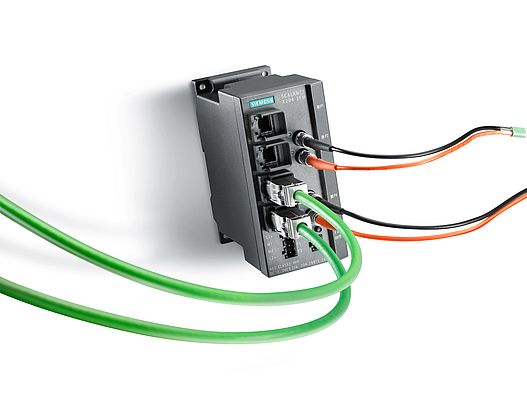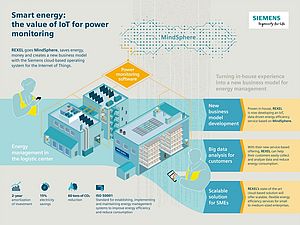Not faced by long Distances With the optical data transmission, electrical pulses are converted by the transceiver into optical signals. By means of plug connectors, the glass fibers are connected to the transceiver integrated into the network component. Depending on the optical wavelength utilized by the transceiver, glass fibers with a matching transmission core must be used. A distinction is made between multi-mode fiber optic cables (multiple light modes are used for the data transmission) and single-mode fiber optic cables (one light mode is used for the data transmission). Due to the low attenuation of the light pulses inside the glass, long distances, ranging from a few to hundreds of kilometers, can be bridged. Since light is not affected by electromagnetic fields, these cables can also be run next to high-voltage lines or electric drives without the data transmitted becoming corrupted. All in all, an ideal solution for a secure communication by Ethernet-based industrial applications in harsh environments.
Convenient Diagnostics - essential for the Industry
For data networks from the office and long-distance traffic areas, these advantages are unbeatable. Most data networks in these areas are set up with glass fiber optic cables. In these applications, mechanical stresses on the glass connections are very low, since the cables are laid or buried just once. Here, the diagnostics is more concerned with the active components; usually with the question: When is the transceiver, the active component processing the data communication over long-range routes, going to fail? In the industrial area, however, there are additional demands on the fiber optic cables. Here, the cables are laid on cable racks in a harsh and often not exactly clean environment. Some fiber optic cables are mounted to drag chains and thus subject to constant movement. A rugged cable construction attempts to protect the fine glass fibers as best as possible. However, all this exposure to temperature fluctuations, movements, or dirt contamination can over time increase the attenuation at the fibers and plug connectors. Measuring instruments and procedures are employed to detect and localize such changes. These instruments, however, are expensive and usually not cost-effective for industrial applications, where only a small portion of the connections consist of fiber optic cables. Despite their many advantages, fiber optic cable connections are thus only used in exceptional industrial situations. To increase the acceptance of fiber optic cable connections in the industrial area, Siemens is offering a new switch from the product line Scalance X-200, which can diagnose each fiber optic cable port and report a change in transmission properties to the user at an early stage. The same functionality is also provided by a media module for the modular products from the product line Scalance X-300.
Avoiding Outages through early Detection
The new switch Scalance X204-2FM (Fiber Monitoring) and the media module MM991-2FM offer optical port diagnostics at both fiber optic cable interfaces, which detects attenuation changes on the route early on. Through a handshake process, the transmitting power of the sender is conveyed to the partner. The partner can then compare the receiving power with the communicated transmitting power: The difference between them is the power lost en route. Minimum/maximum values defined for the transceiver enable the generation of a message based on the change. There are two messaging thresholds: "Maintenance demanded" and "Maintenance required". At the first threshold, the user is informed that larger changes from the norm occurred, which sooner or later will result in the outage of the connection. In this condition, however, a communication is still possible without restrictions. This condition is also signaled by the device through an orange-colored fault LED. Only once the second threshold has been exceeded, communication interruptions can result. Exceeding the threshold values is also reported by the switch via usual channels such as e-mail, SNMP (simple network management protocol), or log file entry. Thanks to this new diagnostic functionality, the user can clearly and in time recognize changes at the individual fiber optic cable routes. An impending outage of a fiber optic cable connection can thus be preempted by replacing the cable or by cleaning/installing new plug connectors.
Easy-to-use: Fiber Optic Cable Diagnostics by Port saves Time and Money
Thanks to the switch Scalance X204-2FM and the media module MM991-2FM, users of industrial applications no longer have to rule out glass fiber optic cable connections. The early detection of changes to the fiber optic cable connection makes it possible to utilize regular maintenance intervals to replace affected cables, before a plant stoppage results in large production losses with financial impact for the plant operator. If the glass fiber optic cabling was implemented with the cabling system FastConnect FO from Siemens, cables can be quickly and easily replaced by plant personnel. The combination of diagnostic-capable fiber optic cable port and FastConnect cabling system results in an end-to-end solution, which aids the user in minimizing plant stoppages and in carrying out on-site fiber optic cable installations, i.e., without a specialized company.



























